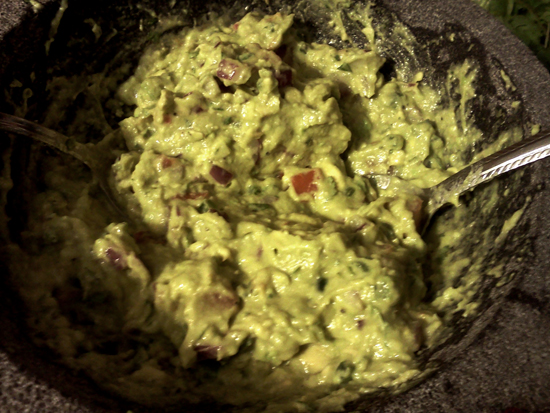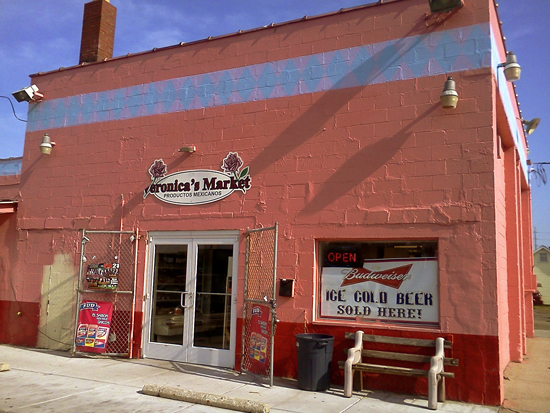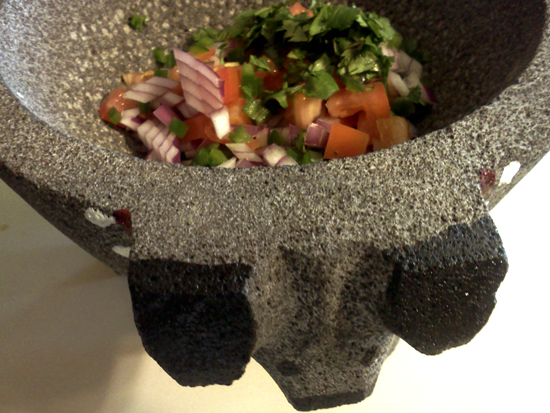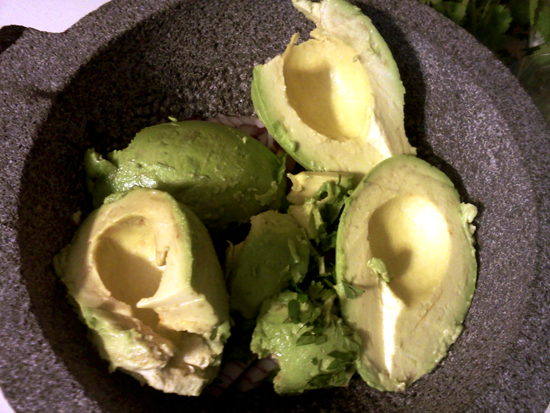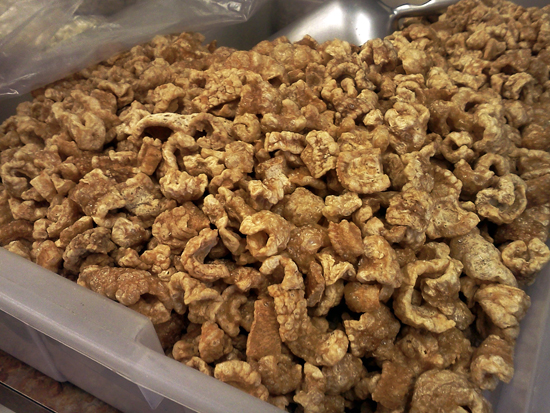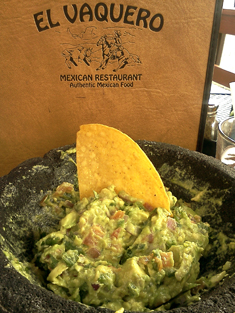 One of the favorite flavors of my life for the past 30 years or so has been that green paste they call guacamole. Back in 1984 Frisch’s Big Boy out of Cincinnati started shipping #10 cans of guacamole to the restaurants in Ohio so the topping/dip could be used in a few new dishes they were rolling out. We received a couple of the large cans at the restaurant I worked at on West Broad St. just outside the I-270 loop. A lot of us had never had the stuff before, so manager Gus Pappas opened one of the cans so we could try what we were supposed to use. It was, as I wrote in the first line above, a “paste”, thoroughly puréed, and a singular pea-soup color throughout. Tasting the quacamole with the same kind of metal spoons we always placed at the tables (using plastic spoons for that kind of thing wasn’t in vogue yet), we found some of the stomachs in the room weren’t quite up to the task. I didn’t mind it, but it was, in fact, slightly odd while still being a little on the intriguing side.
One of the favorite flavors of my life for the past 30 years or so has been that green paste they call guacamole. Back in 1984 Frisch’s Big Boy out of Cincinnati started shipping #10 cans of guacamole to the restaurants in Ohio so the topping/dip could be used in a few new dishes they were rolling out. We received a couple of the large cans at the restaurant I worked at on West Broad St. just outside the I-270 loop. A lot of us had never had the stuff before, so manager Gus Pappas opened one of the cans so we could try what we were supposed to use. It was, as I wrote in the first line above, a “paste”, thoroughly puréed, and a singular pea-soup color throughout. Tasting the quacamole with the same kind of metal spoons we always placed at the tables (using plastic spoons for that kind of thing wasn’t in vogue yet), we found some of the stomachs in the room weren’t quite up to the task. I didn’t mind it, but it was, in fact, slightly odd while still being a little on the intriguing side.
Since that time I’ve had what I always assumed was actual guacamole on numerous dishes, from Taco Bell’s 7-layer Burrito (an unfortunate staple of mine in the late 1990s) to various Tex-Mex salads at joints purporting to be “authentic Mexican” (which in fact were more like New York City-made salsa) to lots of different sandwiches (yes, wraps too) that actually worked rather well with the paste included as one of the spreads.
As embarassing as this is to write, I found just past April 13th that the stuff I’ve been enjoying as guacamole for almost three decades isn’t anywhere near the wonderful goodness and amazing simplicity of the real, authentic dish. On that date, I picked up Mary after work and we headed to one popular BBQ pork restaurant in Toledo for a meal … only to find they were a converted Hot-n-Now and that they’re drive-thru only. Wanting a sit-down meal we headed another mile down the road to The Docks and decided to try El Vaquero, which we’d heard was as authentic Mexican as it gets in Toledo. On our way in we noticed a sign for Tableside Guacamole for $5.99. It sounded intriguing, so once we were seated we asked the server for it as an appetizer.
That’s when things got interesting. The server came back with a busser’s cart with the Tableside Guacamole sign on it. On the top of the cart was a number of metal bins, and the oddest mortar/pestle I’d seen. The thing was carved out of roughstone, and had a face painted on it like a pig. The server added chopped tomato and red onion to the mortar, along with chopped jalapeno. He then cut and pitted two Hass avocados, scooped the fruit out of the flesh and added the fruit to the mortar, along with some chopped cilantro. Finally, he squeezed a lime into the mix and sprinkled salt and pepper over it all. Using two spoons, he then proceeded to mash the bejeezus out of the mixture, then set the whole thing, mortar and all, on our table, just as you see it in the photo on the left. Ok, I’m the one that stood the menu behind it …
That guacamole was nothing at all like any other guac I’ve had in my life. It was thick and chunky, bursting with the individual flavors which contrasted well together while creating an overall flavor like nothing I’d had before. It was seriously addicting, so much so that Mary and I used the still-warm 4″ tortilla chips to polish of the entire mortar full of guacamole.
We had to have more. Mary’s simple question of “You can make this, right?” sent me on a quest these past few weeks. Fortunately, I found everything I needed, almost in one place.
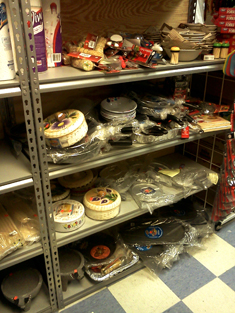 If you’re driving through the city of Adrian in southeast Michigan just north of the Ohio line, you wouldn’t have much of a clue that there’s a fairly large Mexican community there. In the small downtown area is a single authentic restaurant, The Grasshopper, El Chapulin, that even serves a rather decent bowl of Menudo, the beef tripe and hominy stew that turns the stomach of so many sqeamish Americans. But southeast of the downtown area there’s a square mile or so straddling East Beecher Street between South Winter and Parr Highway that’s home to almost the entire Mexican community of the area. There are small buildings along Beecher offering handmade tacos and chalupas, a place called The Tamale Factory run by three generations of women that’s basically a hole-in-the-wall in the corner of an old auto shop, a small Mexican family sit-down restaurant called Mario’s Mexican Restaurant on the north side of Beecher between Oak and Treat that you can’t even get into at lunchtime because it’s so packed, a great family restaurant at Maumee and Dorothy called the Sunny Side Café that serves the most amazing Mexican breakfast dishes …
If you’re driving through the city of Adrian in southeast Michigan just north of the Ohio line, you wouldn’t have much of a clue that there’s a fairly large Mexican community there. In the small downtown area is a single authentic restaurant, The Grasshopper, El Chapulin, that even serves a rather decent bowl of Menudo, the beef tripe and hominy stew that turns the stomach of so many sqeamish Americans. But southeast of the downtown area there’s a square mile or so straddling East Beecher Street between South Winter and Parr Highway that’s home to almost the entire Mexican community of the area. There are small buildings along Beecher offering handmade tacos and chalupas, a place called The Tamale Factory run by three generations of women that’s basically a hole-in-the-wall in the corner of an old auto shop, a small Mexican family sit-down restaurant called Mario’s Mexican Restaurant on the north side of Beecher between Oak and Treat that you can’t even get into at lunchtime because it’s so packed, a great family restaurant at Maumee and Dorothy called the Sunny Side Café that serves the most amazing Mexican breakfast dishes …
… and right there at the corner of Beecher and Gulf is one of my own favorite places to shop, Veronica’s Market.
Even though the market has been on my radar for a while, I’d never bought anything in the way of cooking tools from them. I’d vaguely recalled seeing some mortars at the bottom of the tool rack but it had seemed to me they were marble or some other kind of stone. Last week, though, when I headed in to actually look at the mortars and pestles, which are actually called a molcajetes and tejolotes, I found them to be of the exact same pig design as the ones used at El Vaquero. At that point I knew I was in business, and at $17.99 for the thing I just had to get one and get going with it.
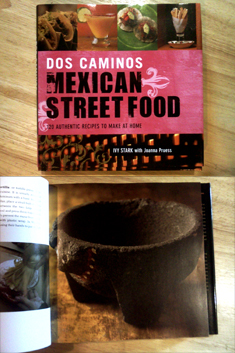 Looking around the web for guidance wasn’t as revealing as I’d hoped it would be. One of the main issues I found was that a large number of recipes call for a bowl, not a molcajete. While some may consider such a point to be mere quibbling, it would seem to me that if you are attempting to make any kind of an authentic dish from any type of cuisine, you’d better darn well be specifying and using the correct authentic tools for the job as well. You know, it’s just like this: If you’re making Chinese food you need to use a wok over a high-temp gas burner, not a skillet on an electric stove. When we had the Tableside Guacamole at El Vaquero, there was also a cultural experience involved which added a certain value to the dish. If the server had made it in a bowl I doubt it would have had the same impact. His use of the molcajete brought forward our own respect for the Mexican culture, which was part of what I wanted in the dish when I finally made it myself.
Looking around the web for guidance wasn’t as revealing as I’d hoped it would be. One of the main issues I found was that a large number of recipes call for a bowl, not a molcajete. While some may consider such a point to be mere quibbling, it would seem to me that if you are attempting to make any kind of an authentic dish from any type of cuisine, you’d better darn well be specifying and using the correct authentic tools for the job as well. You know, it’s just like this: If you’re making Chinese food you need to use a wok over a high-temp gas burner, not a skillet on an electric stove. When we had the Tableside Guacamole at El Vaquero, there was also a cultural experience involved which added a certain value to the dish. If the server had made it in a bowl I doubt it would have had the same impact. His use of the molcajete brought forward our own respect for the Mexican culture, which was part of what I wanted in the dish when I finally made it myself.
On the web it turned out that, a little more than four years ago, Journalism Professor Holly A. Heyser had posted almost exactly what I was looking for on the hunting blog she was writing at the time. She doesn’t write that particular blog anymore, focusing elsewhere on her freelance writing and photography. In case her older work disappears at some point, I’ll repost a couple of her points about the molcajete which were most important to me:
Q: So how do you clean it?
A: Easy: I put it in the sink, run hot water in it and add a little dish soap, then use a scrub brush to get into all the pits and pores. You won’t be able to get out all the green bits – they really stick in there. But it’s OK. No one has died from eating guac out of my molcajete. After scrubbing, rinse thoroughly to get out all the soap, then turn it upside down to drain. It takes a while to dry out completely, because it’s a big stone sponge.
Alternate method: Rinse it out and stick it in the dishwasher.
Q: You mentioned something about curing the molcajete. What’s up with that?
A: The molcajete is made of stone, and if you just start using it straight off the shelf, you’re going to get bits of stone in your food. Not so good for your teeth!
To cure it, you dump in a handful of uncooked rice, grind it down, rinse it out, and repeat 3-5 times until the rice no longer looks gray at the end of the grinding. I won’t lie – this process is a total pain in the butt. But it’s worth it when you make your guac and all the people who eat it tell you it’s the best guac they’ve ever had. Your big fat head will make you forget all about the torture you endured.
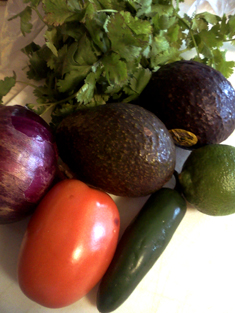 While Ms. Heyser’s version of the guacamole was actually quite close to what I was looking for, there were some variations to it that were a bit different from what they did at El Vaquero. Most importantly, the technique and process were a little more involved than the simplicity we had seen at the restaurant. Her version uses the tejolotes to grind the ingredients to “pulpy bits”. While this certainly does sound good, I didn’t recall seeing the tejolotes at El Vaquero. This seemed important somehow.
While Ms. Heyser’s version of the guacamole was actually quite close to what I was looking for, there were some variations to it that were a bit different from what they did at El Vaquero. Most importantly, the technique and process were a little more involved than the simplicity we had seen at the restaurant. Her version uses the tejolotes to grind the ingredients to “pulpy bits”. While this certainly does sound good, I didn’t recall seeing the tejolotes at El Vaquero. This seemed important somehow.
Digging through my collection of more than 200 cookbooks I was somewhat shocked (I guess more like irritated) to find I’d never once picked up any kind of Mexican cookbook, authentic or otherwise. Michigan-based Borders Bookstores have all closed recently, so I headed to my second choice, a Barnes & Noble in north Toledo … only to find their cookbook section has been pared down to a whole three sets of shelves. And of course, the one “authentic” Mexican cookbook had the guacamole being made in a bowl …
Frustrated, I made the 12-mile-or-so drive to the large Books-A-Million store in Perrysburg, which is south of Toledo. There I found the cookbook section to still be an entire aisle, eight sets of shelves, with a decent selection of Mexican cookbooks.
Looking through all of the cookbooks spread across more than one shelf I discovered only one mentioned using a molcajete to make the guacamole. The book is Dos Caminos Mexican Street Food by Ivy Stark, Executive Chef at Dos Caminos and other restaurants in New York City and elsewhere. And lo-and-behold, the small chapter on equipment also included a photo of the same molcajete used at El Vaquero, the same one I had bought at Veronica’s Market.
Dos Caminos Mexican Street Food might soon become one of my most-used cookbooks. Street food can be an amazing thing, and when ethnic street food is done right it can be downright addicting. The guacamole recipe on page 71 sounded suspiciously familiar. And interestingly enough, the introduction to the recipe read in-part;
We prepare it tableside in a lava stone molcajete according to each guest’s specifications.
With this particular book added to my collection, I only needed to do one more thing.
For Cinco de Mayo of 2012 last week we took two of our kids and our granddaughter to El Vaquero for an appropriate and authentic Mexican dinner. Of course we asked our server for the Tableside Guacamole. A woman brought the cart to our table and began to make the guac. I started asking questions, only to find out she spoke very little English. I paid particularly close attention to what she was doing so I could possibly recreate it later, making mental notes on all the ingredients and processes. The guac was just as good as it had been the first time, if not even better. I asked our server about the “Guac Girl” and found out she is actually the owner’s wife! She hasn’t been in the U.S. for very long, but obviously she makes some of the best guac around. I mentioned what I was doing and where I’d bought the same molcajete. Our server was dumbfounded … He explained they had bought thirty of them for the large restaurant and had paid at least thirty dollars for each. More reason to like Veronica’s Market I guess …
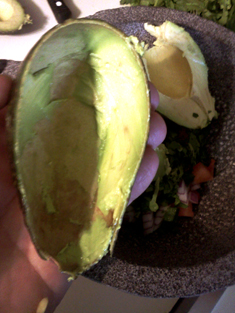 With a plan in mind, gathering the ingredients turned out to be a bit on the interesting side. I headed to one of the “normal” American groceery store, and was sorely disappointed. $4.49 for three avocados that didn’t look so great anyway?? No thank you … I headed back to Veronica’s Market where I’d picked up the molcajete. The owner there had been kind enough to give me bits and pieces of advice, but now went full bore into it. For example, the Wikipedia entry for avacodo states, “A ripe avocado yields to gentle pressure when held in the palm of the hand and squeezed.” The owner doesn’t like people squeezing his avocados like this to test them as the fruit inside the flesh becomes bruised. So he keeps the avocados inside the walk-in cooler. He headed in there and came out with four beautiful, ripe Hass avocados. Looking at the sticker I discovered these weren’t from California as most recipes I found specified. They were actually from Mexico. I’m not sure if this makes any difference but it sounds good anyway … I also grabbed a few jalapeños, some key limes, Roma tomatoes and a nice bunch of cilantro out of the wall cooler. The red onions, which is what El Vaquero uses in their Tableside Guacamole instead of white onions, weren’t in the vegetable bins at Veronica’s Market, so I headed to another market in Adrian to grab some.
With a plan in mind, gathering the ingredients turned out to be a bit on the interesting side. I headed to one of the “normal” American groceery store, and was sorely disappointed. $4.49 for three avocados that didn’t look so great anyway?? No thank you … I headed back to Veronica’s Market where I’d picked up the molcajete. The owner there had been kind enough to give me bits and pieces of advice, but now went full bore into it. For example, the Wikipedia entry for avacodo states, “A ripe avocado yields to gentle pressure when held in the palm of the hand and squeezed.” The owner doesn’t like people squeezing his avocados like this to test them as the fruit inside the flesh becomes bruised. So he keeps the avocados inside the walk-in cooler. He headed in there and came out with four beautiful, ripe Hass avocados. Looking at the sticker I discovered these weren’t from California as most recipes I found specified. They were actually from Mexico. I’m not sure if this makes any difference but it sounds good anyway … I also grabbed a few jalapeños, some key limes, Roma tomatoes and a nice bunch of cilantro out of the wall cooler. The red onions, which is what El Vaquero uses in their Tableside Guacamole instead of white onions, weren’t in the vegetable bins at Veronica’s Market, so I headed to another market in Adrian to grab some.
In making this recipe successfully the very first time I did it, I learned a few things. First of all, getting the pits out of ripe avocados and scooping the fruit out of the flesh is considerably less stressful than I’d imagined. In fact, it was probably the easiest part of the entire process. Also, the membrane needs to stay in the jalapeño when you seed it so more heat remains, else you may as well not even add it. And finally, don’t have anyone who might really like it test it for you. You may not get the guacamole back, let alone have any left for the rest of the family when they get home.
Before the recipe, some “food porn” … a shot of the bin of fresh-made pork rinds that sits next to the register at Veronica’s Market. I can’t stand commercial pork rinds myself, but these things? I could probably eat this whole bin given the chance …
Recipe: Authentic Molcajete/Mortar Guacamole
This recipe looks rather involved, but really it’s not. I’ve included a lot of descriptive steps for beginners who may not know how to accomplish some of the processes. This is actually quite simple. We hope you like it as well as we do.
Ingredients
2 ripe Hass avocados
1 large Roma tomato
1 red onion
1 jalapeño or serrano pepper
1 key/Mexican lime
fresh cilantro
sea salt
ground black pepper
Cut two slices of the red onion and give it a rough chop until there’s a couple tablespoons. Chop half the tomato the same size and amount as the onion, and add both to the molcajete. Cut the jalapeño or serrano pepper in half, remove the stem and the seeds (leaving the membrane), chop it half the size as the onion and add it too to the molcajete.
Using a sharp knife cut the avocados in half around the pit. Twist the halves in opposite directions to pull them apart … the pit will stay in one half. Hold that half in your palm and, with the knife in the other hand, plant the edge of the blade near the handle firmly in the pit. Twist the pit firmly with the knife and the pit will pop out of the avocado fruit. Using a large metal spoon, separate the fruit from the flesh on one side and gently scoop the fruit into the molcajete. If the avocado is exactly ripe, it will all come right out. Repeat with the other halves of avocado.
Roll the lime back-and-forth on a hard surface a few times to get the juice flowing. Cut in half along its equator and squeeze the juice from each half into the molcajete, throwing the juiced lime away. Give a couple teaspoons of the cilantro a fine chop and add it as well.
Using a couple large metal spoons fold everything together. Then simultaneously fold and chop the entire mixture together, continuing until it’s well-blended. Add a little of the salt and ground pepper and mix it in. Taste the guacamole, and add more salt and/or pepper as needed.
Serve directly out of the molcajete, allowing people to dip corn chips directly into it to eat.
